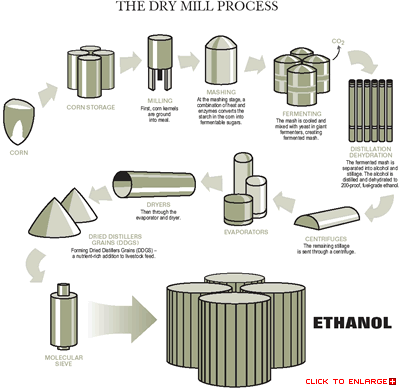|

How ethanol
is made -- from the corn plant to the production plant.
So how is a bushel of corn transformed into more than two
gallons of high-performance fuel? It’s an eight-step process
that takes several days.
1. Milling around
The corn is ground into small particles. This exposes the
cornstarch, which will be used for the fermentation process. The
cornstarch is removed and milled into a fine powder. The
remaining grain material — protein, fiber, vitamins and minerals
— is used for livestock feed.
2. We’re cookin’ now
The cornstarch powder is mixed with water and alpha-amylase, an
enzyme that helps break the starch into smaller particles. The
resulting mash is cooked at 120 to 150 degrees to liquefy the
starch and reduce bacteria levels, then heated to 225 degrees to
help break the starch down further.
3. Sweet!
The mash is removed from the cookers and cooled. Then a second
enzyme, glucoamylase, is added to help convert the liquid starch
into a sugar (dextrose) that can be fermented.
4. Destination: Fermentation
The mash is mixed with yeast, which changes the sugar to ethanol
and carbon dioxide. It takes about 48 hours for the mash to
ferment.
5. In distill of the night ...
The fermented mash contains about 10 percent ethanol. The rest
of the mixture is water and corn/yeast solids that couldn’t be
fermented. To separate the ethanol, the mixture is heated once
again — this time to a temperature at which ethanol vaporizes,
but the remaining materials do not. The ethanol vapor is
collected and cooled, where it condenses to its liquid form.
6. Dehydration
To purify the ethanol and remove any remaining water, it’s
passed through a dehydration system, creating anhydrous ethanol
(anhydrous means “without water”). After this step, the ethanol
is approximately 200 proof ... which explains the need for step
seven.
7. Potent, but not potable
To make the ethanol unfit for human consumption — a requirement
for all fuel-grade ethanol — a small amount of gasoline is added
(2 percent to 5 percent).
8. On the side
The leftovers, or co-products, of the process — distiller’s
grain and carbon dioxide — are saved. Distiller’s grain is a
highly nutritious livestock feed, and carbon dioxide is
collected, purified, compressed, and sold for use by the
carbonated beverage and dry-ice industries.
 |


